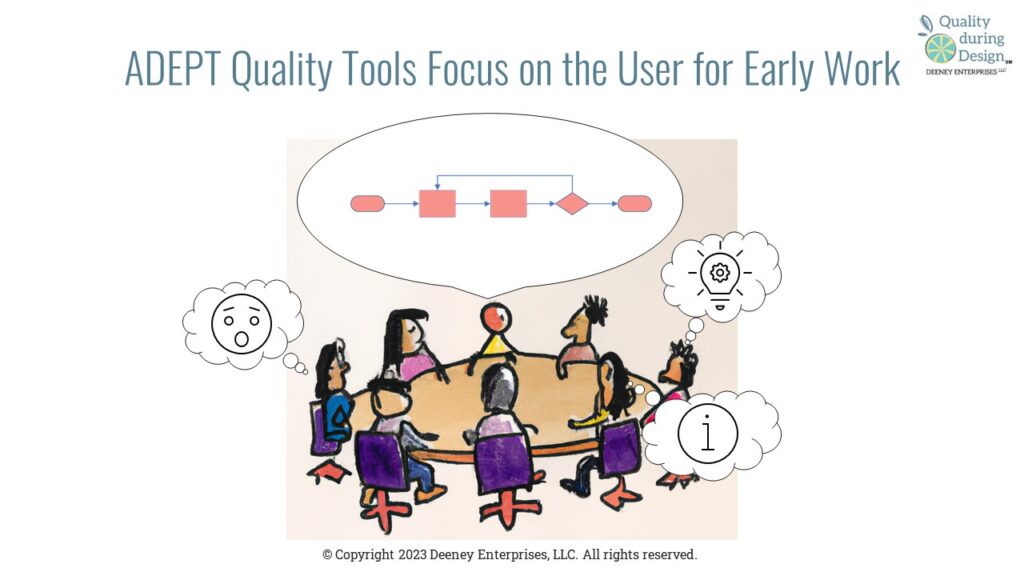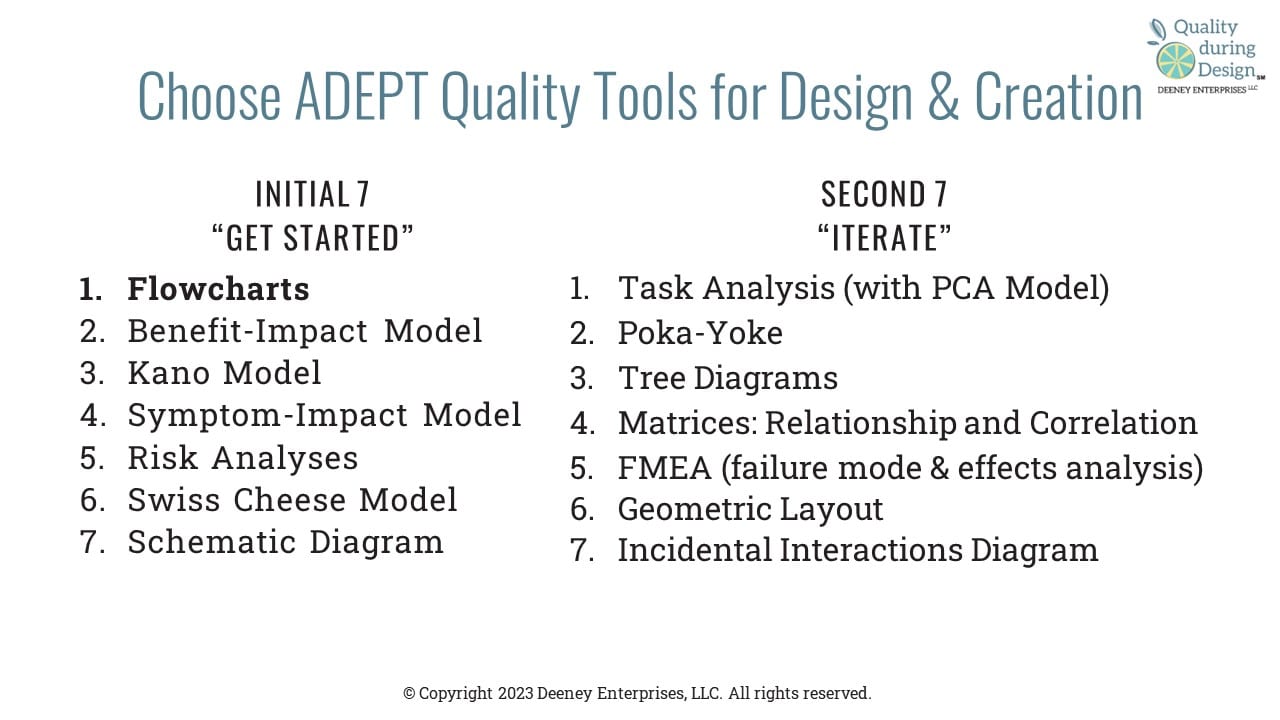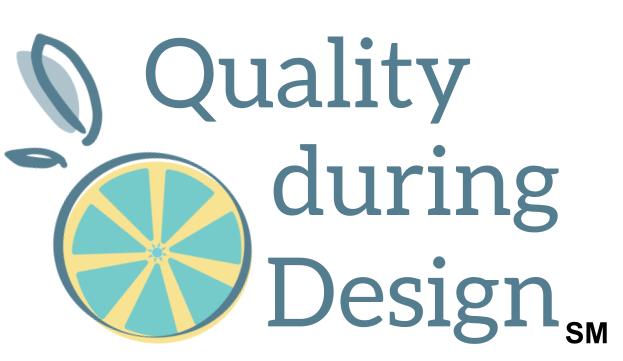In the quality world we have a lot of quality tools and frameworks and reliability methods that we use for monitoring and for continuous improvement. Did you know that design teams and cross-functional teams can use many of these same tools for design and creation?
Welcome back to Quality During Design. In the last two episodes we've been talking about the product designer's role in early concept development, how we want to stay in the problem space a little bit longer, and the benefits and challenges and how to overcome the challenges of working with our cross-functional team and cross-functional collaboration in that early concept development.
Today, we're talking about leveraging proven quality and reliability frameworks for concept development. We're going to be talking about how we can adapt these frameworks to drive effective conversations about an idea. Listen in to learn more after this brief introduction.
Hello and welcome to Quality During Design, the place to use quality thinking to create products others love for and less. Each week, we talk about ways to use quality during design and product development. I'm your host, Dianna Deeney. I'm a senior-level quality professional and engineer with over 20 years of experience in manufacturing and design. I consult with businesses and coach individuals on how to apply quality during design to their processes. Listen in and then join us. Visit qualityduringdesigncom.
Just a few weeks ago, I was a guest on a webinar series with Scott Abel, The Content Wrangler, and Herreto. I was talking to technical communication experts about using flowcharts for their product designs, for instructions, user manuals and other user interfaces that technical writers get involved with. Today's episode is an excerpt from that webinar. I talk about the history of quality tools, why we call them that, how they're used, how we can use them for design and creation. If you'd like to see the webinar episode itself, or you can see the slides that I was using to talk against sometimes, visit qualityduringdesign.com. You'll see a link to that workshop that I gave. You can sign up for a free account and view the recorded webinar. Now let's get into how we can leverage proven quality frameworks for concept development.
Now about quality tools. I usually get a question about what is a quality tool. I don't understand why you call it that, and I also get an understanding from people that well, why are you doing quality early? Isn't that checking parts at the end of the assembly line? Aren't you measuring parts and deciding if they're good or bad?
So let me tell you a little bit about the history of quality tools. Kaoru Ishikawa was really active in the quality world in the 1950s and 60s, but he was still publishing up until the 1980s. He was in Japanese industry and a lot of quality professionals know who he is. He's like one of the grandfathers of quality and he had published and he promoted these seven basic quality tools and said that as much as 95% of all quality related problems in the factory can be solved with these seven tools. Now the story has it is that he picked seven as the seven tools because he had in mind the story of the seven weapons of Benkei. Benkei was a warrior monk that lived in the 1100s. He's depicted as very strong and loyal and he's still depicted in some current productions today, like in anime and in video games, and I also saw a reference about him being in an American detective show, but I couldn't find any more about that. I don't know any more about him being part of a detective show, but he did have seven weapons, which is why we think that Ishikawa referenced the seven quality tools.
So here are the first seven, or the old seven that Ishikawa really promoted is on the left hand side, and you'll hear quality practitioners talk about them as the first seven when things have been around for a long time after about 80 or so years, there's going to be development and new people are going to get involved. So now we have the seven plus basic quality tools. Scott and I were talking a little bit earlier. These tools don't really give you a solution. They are a way for you to investigate problems, have discussions so that you can get the information together to be able to make a decision. So think of them as tools in a toolbox. You wouldn't want to use a hammer on everything you get to choose the tool that's going to make the most sense to help you solve a problem.
Knowing the story of Benkei and the origin of these seven quality tools, you do get the impression that it's more of a warrior type of thing, that we are attacking problems and we are, you know, getting rid of things that cause bad quality, and a lot of people do think of quality as monitoring and continuous improvement. But I've learned through my working journey that quality tools can also be used for design and creation. Let me tell you what I mean. When we're thinking about designing a product, you know, when we go from, "Hey, we have a problem!" and we start thinking about the solution. We kind of think about this simple model: our design, or whatever it is that we're working on, is in the middle in the square, and then we have inputs and then it's outputting something. But we focus in on that system model when really what we need to do is develop less solutions around that system and do more discovery about what's going on around the system. If we take a big step back, we can use little bees to represent our customers and they're really on the outside of our design, which is the way it should be.
- We have at the beginning of their inputs. We're meeting our customers somewhere. They have certain conditions and they have assumptions where there's some place, where they are and we want them to be able to use our products so they can be somewhere else. And that is where the intended outputs come into play.
- When our design works the way it should, our customers are going to see benefits,
- and when our design doesn't work like it should, they're going to have experiencing symptoms to the problem.
- And, of course, at the top is what I call the the use process. We want our users to go from A to B, to have some sort of a journey, and they're going to be interacting with our product to be able to take that journey.
Ultimately, we don't want to stay in the outside. We do need to get to work and actually get a design done. So we're. Even though we're exploring this outside customer space, we're still focused on what we need to be able to make design decisions, and this is how quality tools can help with design and creation. Quality tools can be graphical, they can be prompted and they can be iterative. You can also scale them to be what it is.
- You need Alignment exercises, for the team could be getting alignment on the users and the user needs, or comparing ideal versus actual, or which need for which user.
- We can discover hidden needs and interfaces.
- We can examine use experiences for design inputs
- and we can prioritize parts of the use process.
So ADEPT teams work early, using quality methods to align their knowledge, discover through prompted activities to enhance ideas and prioritize them. What are your early concept working team meetings like? So somebody has come up with idea and then everybody decides let's get together and talk about what to do with this idea. There isn't a whole lot to talk about, right? You haven't designed anything yet, which I think is one of the itches for a lot of people, skipping that middle, second half of the problem space. We don't know what to talk about, there's nothing to talk to or examine, whereas we can use quality tools as a substitute for that.
We're using quality tools to explore the use space and we can talk to it and talk against it, and today we're specifically going to be talking about using flow charts as the quality tool to be able to work with our team to do early problem space discovery. I have my initial seven to get started and then I have the second seven to iterate, and there are a lot of tools on this list but again, we don't use them all. We use what makes sense for what we need and then we can iterate on the things that are most impactful or for the questions that we still have to do more. If some of you work in regulated industries, you might recognize some of these tools as being required use anyway.
So what's today's insight to action? In early concept development, we don't have a lot to talk about. One of the solutions that we try is to jump ahead and start designing solutions so that we can have something to talk about, something to edit and something to move forward with and to discuss. That's where we get into the trouble of not really exploring the problem space enough to start designing. Instead of designing something to talk about, we can use quality tools as a substitute. Quality tools are, by nature, graphical, they're very adaptable and they're very approachable for teams to be able to use to explore ideas. They're the perfect kind of tool to start developing design inputs from concepts, from high level ideas.
Tune in next week while I will share some practical tips of how you can apply some quality frameworks to get those design inputs and also to prioritize them based on the user. As always, qualityduringdesign.com has a blog associated with this podcast. Visit it for transcripts and extra links. And just a reminder if you wanted to view the recorded workshop, go to qualityduringdesign.com slash workshops for the link. This has been a production of Deeney Enterprises. Thanks for listening.
 Ready to sharpen your toolset with the wisdom of ancient warriors?
Ready to sharpen your toolset with the wisdom of ancient warriors?


